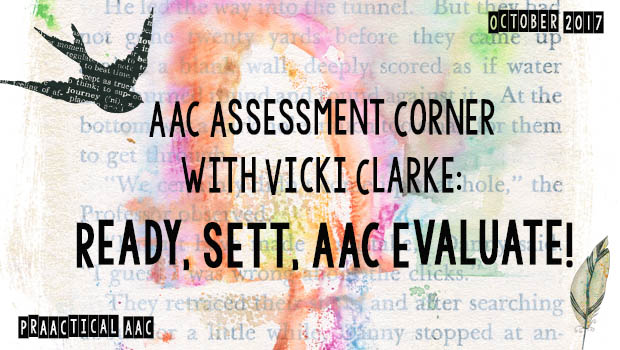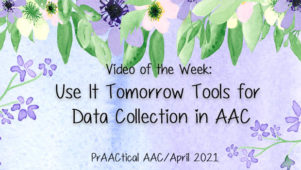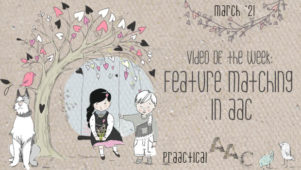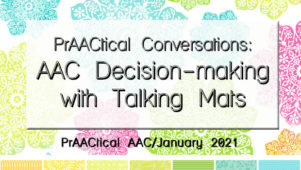AAC Assessment Corner with Vicki Clarke: Ready, SETT, AAC Evaluate!

She’s bAACk ! We couldn’t be happier to have another guest post on AAC assessment practices from Vicki Clarke of Dynamic Therapy Associates. In today’s post, she shares her tips and experiences for applying the SETT Framework to AAC assessment.
! We couldn’t be happier to have another guest post on AAC assessment practices from Vicki Clarke of Dynamic Therapy Associates. In today’s post, she shares her tips and experiences for applying the SETT Framework to AAC assessment.
If you are looking for information about how AACtual SLPs conduct their evaluations, Vicki’s posts are just what you need. You can view her previous contributions to the AAC Assessment Corner here.
::::::::::::::::::::::::::::::::::::::::::::::::::::::::::::::::::::::::::::::::::::
Ready, SETT, AAC Evaluate!
Last week I had the pleasure of joining the AAC After Work online conference hosted by Yapp Guru University. Jenna Coyer and I presented a session chatting about AAC assessment in emergent communicators. As we have worked to define our process for evaluation, we found ourselves repeatedly returning to the same approach our Assistive Technology teams use—the SETT Framework.
The SETT Framework was developed by Joy Zabala as a process for making decisions about assistive technology supports for students. Joy proposes that before we simply plunk tools into place for a student, we need to carefully consider these factors:
S: Student
E: Environment
T: Tasks (Communication, for us!)
And then finally…
T: Tools
Most of us interested in assistive technology LOVE all the gadgets, gizmos, go-talks, and
HIGH TECH COMPREHENSIVE COMMUNICATION DEVICES (AND APPS!).
It’s so tempting to take a one-size-fits-all approach and give all of our students a device or app to fix their communication problem. It’s easy, it’s fast, and we feel we have accomplished something. I see this desire manifested in most of the school districts where I work, and in the majority of families who contact our AAC specialized speech therapy clinic. I cannot tell you how many times I’ve been called “The Device Lady.” Deep Sigh.
The SETT Framework pushes our focus away from the tool initially and focuses squarely on the student, their world, and specific needs. We simply need to know what we are going to do with a tool before we purchase it. Almost every classroom I enter has a Smart Board in it and I very often find that they are used primarily to play YouTube videos during Morning Meeting. Can you imagine how many iPads with AAC apps we could buy with that money? Determining need first saves us money, energy, and disappointment in the long run.
Let’s take a look at the SETT Framework and how it relates to AAC decision making. Just like our teachers and families, we AAC practitioners have to be smart about our tool selection too.
I’ve been using the SETT Framework in three ways:
- To plan my assessments by identifying the tools I will use to understand the student and his environment and communication tasks.
- To describe the student, environment and communication tasks (needs).
- To write an evaluation assessment that is more than sufficient to justify purchasing the tools I recommend.
Keeping the SETT Framework in mind, our AAC assessment planning and tool selection look like this.
Student:
When evaluating the student, we are considering their receptive/expressive language skills, interests, motivations, sensory skills, and physical access skills. We will be looking at their learning styles: visual learners, auditory learners, tactile learners, and experiential learners. Do they learn best introduced to isolated information in a structured, simplified presentation, or do they thrive by learning in context with lots of examples, activities, and models? To assess these areas, we use a variety of tools, or portions of tools. We evaluate by listening (interview tools), watching (observation tools) and direct student assessment (checklists, tests and trials). Here are some of the tools we use:
Interview Tools:
- Home Talk: A Family Assessment of Children Who Are Deafblind
- Every Move Counts-3: Communication Assessment Section
- AAC In The Schools: Best Practices for Intervention
Observation Tools:
Clinical Assessment Checklists- Partner Informed:
Hands-On AAC Assessment:
- AAC Evaluation Genie App
- Test of Aided-Communication Symbol Performance
- Dynamic AAC Skills Assessment-R
Environment:
Our assessment of the environment includes looking at the partners, physical environment, and activities. We ask about partner hopes and desires for their AAC user and their frustrations with communication challenges. We look at the partners’ resources to support their AAC user, their knowledge, interest, commitment, skills, and motivations. In schools, we talk to the administration to garner their support and make sure the teachers have the time and materials they need to assist the student. Knowing these helps us to select tools that partners will be willing and able to implement. Without daily partner involvement, AAC instruction in isolated settings will be insufficient to help a non-speaking person gain functional communication skills.
When we consider the physical environment, we need to know the characteristics that may influence our choice of AAC supports such as how loud, wet, bright, or small the space is. AAC users never use one method of communication and usually, this is dependent on the environment. For example, a child does not take her Accent into the bathtub or his 3×3’ eye gaze frame in the family’s Civic.
Communication Tasks
Understanding the communication task a person must accomplish in their environment involves at least 3 considerations:
- Functional Messaging Needs: What words and messages does the person need to be successful in their home, school, and community?
- Language Development Needs: What language skills, such as vocabulary and message construction knowledge, does the person need to be able to develop at an age appropriate level?
- Social Relationship Needs: How does a person need to communicate in order to develop and maintain personal relationships?
Functional Messaging Needs:
Daily schedule analysis is a technique I initially learned about in 1991 from George Karlen, a Purdue researcher, who presented the concept at ISAAC. Goossens, Crain, and Elder also developed the idea of using a schedule analysis to determine vocabulary selection in their series of books, Engineering the Preschool Environment for Interactive Symbolic Communication: 18 months to 5 years Developmentally and Engineering Training Environments for Adolescents and Adults Who Are Moderately/Severely Developmentally Delayed. My own personal attempts to recreate this concept have gone through a myriad of editions over the last 20 years.
Although the idea of analyzing a person’s schedule was initially proposed as a method of determining which words and messages to target, I find it helpful in understanding what is required in the home and classroom. As with most evaluation objectives, this leads us toward intervention, and schedule analysis is one of those tasks. The basic idea is that we document the person’s daily activities, determine what words and messages they need to be successful, and then prioritize the messages we want to target first.
Here are some of the most recent revisions of my schedule analysis:
Classroom Communication Project: Schedule Analysis
Language Development Needs:
Determining the language development needs falls more under the “Student” section of our SETT Framework. We do this by assessing developmental norms for our students with checklists and evaluations.
Social Relationship Needs:
Pat Mirenda introduced us to the Participation Model in the book Augmentative and Alternative Communication: Supporting Children and Adults with Complex Communication Needs co-authored by David Beukelman. (Geek Side Note: I have every version of this book.) In this classic textbook, they give us a form that helps us compare our non-speaking child with his peers in terms of functional communication within observed activities/settings. This allows us to determine the standard for communication for our student. I used the exact tools in this book to develop my very first AAC implementation documents, so I’ll just refer you to the source!
Tools
Once we really understand our student, the environment, and the task they need to accomplish, we can apply the tools they need. That’s not the end of SETT though. As Joy Zabala tells us, SETT and ReSETT often! Our children, their environments, the communication tasks, and even the tools change as they move through new schools, new teachers, develop themselves and technology marches on!
Filed under: Featured Posts, PrAACtical Thinking
Tagged With: AAC assessment, SETT, Vicki Clarke
This post was written by Carole Zangari





1 Comment
Hi there!
I cannot access the dynamic aac skills assessment! Would you be ok posting this again or emailing?